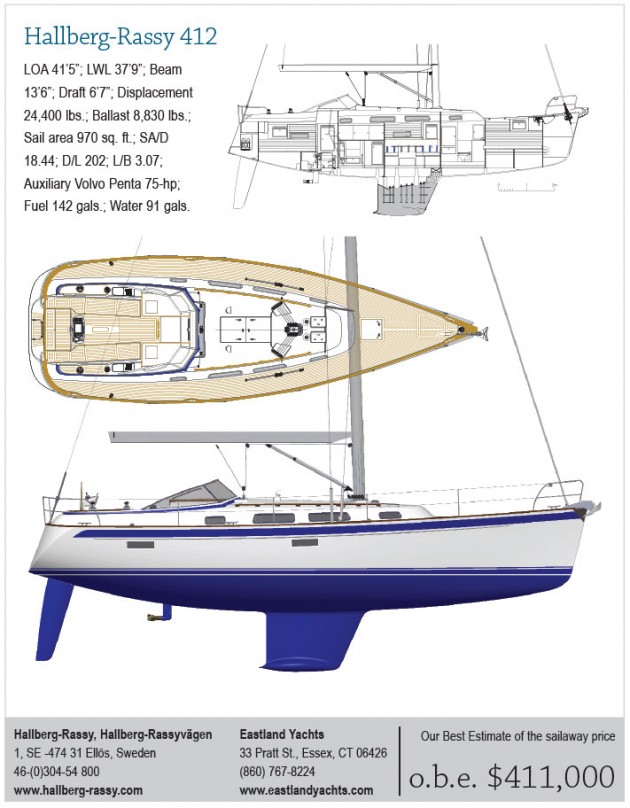Hallberg-Rassy 412
It's interesting to look back at the first Hallberg-Rassys. I remember them as being stalwart, offshore boats with very conservative hulls. But in keeping up with current design trends and linking up with a renowned designer, Germán Frers, H-R's newest model looks almost like a racing boat of today. Of course the 412 is a cruising boat so it has far more comfort components than a racing boat, but look at the hull.
This is a beamy boat with an L/B of 3.07 and a D/L of 202, making it a light cruising boat. The ends are very short and there is only 3 feet, 8 inches of total overhang. This means the sailing length of this design will be maximized for speed and the volume aft will be enhanced for accommodations. You could also argue that a fat stern adds stability and you would be correct. I guess it's just luck that volume aft helps with speed and comfort. The keel is outside lead on a deep GRP sump. Draft is 6 feet, 7 inches. This is a pretty low aspect ratio fin keel for a cruising boat. I don't see anything wrong with that. It just shows dramatically the change in the accepted shape of cruising boat keels. The rudder is a deep spade, another change from the low-aspect, skeg-hung rudders of the old models. Maybe the definition of "performance" is changing too.
This is a true mix and match interior. There is a standard layout and three optional layouts. If you added the option of the starboard saloon chairs to the others you'd have even more layouts. The standard layout has two staterooms with doubles and two heads with a large cockpit locker to starboard aft. If you keep that layout and add a stateroom to starboard aft and shorten the aft head a bit you'd have Option 1. Stay with Option 1 and take out the aft head and you have Option 2. Take Option 2, shorten the forward head and add some lockers in the forward stateroom, throw in a couple of reading chairs to starboard in the saloon then put the standard layout's big aft head in again and you have Option 3. Suffice to say there is one layout that will suit you. I like Option 2. I think one head is enough. They are all comfortable and practical layouts.
The rig geometry is also a far cry from the old masthead cutter approach. The tall rig with minimal overlapping headsails has an SA/D of 18.44. This is not high but it's not anemic for a cruising boat either. The headstay is tacked about 14 inches aft of the stem, leaving room to tack an asymmetrical chute to the end of the anchor roller fitting. The mainsheet is midboom and that's something you would not see on a racing boat. But it's convenient for when you need a cockpit dodger. The triple spreaders are swept and the mast is deck stepped. Add about 24 inches of roach, get the mainsheet traveler back where it works and this could be the rig off a racing yacht.
The deck plan has the halyards leading aft from the mast under panels that span the housetop. The tall height of the cockpit coaming makes it easy to keep those lines, including the mainsheet, buried until they emerge on the top of the coamings port and starboard at a bank of clutches. This lets four winches do all the jobs while being close by the helmsman. The cockpit seats are nice and long for napping. I might consider moving the helm forward so that you could drive while getting shelter from the dodger. The helm seat opens up for access to the swim step. The side decks are very clean. There is a low molded bulwark and a rubrail about nine inches below the sheer, which, I should add, has some perkiness to it and I like it. The windshield is an H-R trademark by now and I think it adds visual interest to the design. I like the long foredeck too. Despite the rather high freeboard I think this is a very good-looking boat.
It's pretty hard to fault a design like this.

Comments